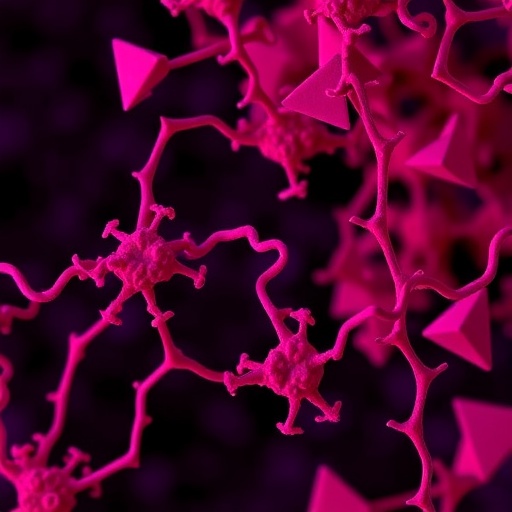
Nicotinamide adenine dinucleotide (NAD⁺) has emerged at the forefront of cellular metabolism as a fundamental coenzyme driving energy homeostasis and physiological regulation. Recent cutting-edge research highlights its pivotal role, not only in classic bioenergetic processes such as glycolysis, oxidative phosphorylation (OXPHOS), and fatty acid oxidation but also in a multitude of non-redox functions critical for cellular integrity. This expanding knowledge marks a transformative understanding of NAD⁺ metabolism, with implications that span aging, metabolic disorders, cancer biology, and neurodegeneration.
At its core, NAD⁺ serves as a quintessential electron carrier, shuttling electrons during metabolic reactions to sustain ATP production. However, its functions transcend mere redox chemistry. NAD⁺ is also a substrate for a collection of NAD⁺-dependent enzymes, including sirtuins, poly(ADP-ribose) polymerases (PARPs), and cyclic ADP-ribose synthases, which participate in regulating gene expression, DNA repair, and calcium signaling. These multifaceted roles position NAD⁺ as a lynchpin in maintaining cellular homeostasis, responding dynamically to physiological cues and stress.
Integral to the regulation of intracellular NAD⁺ levels is the nicotinamide phosphoribosyltransferase (NAMPT)-mediated salvage pathway. NAMPT catalyzes the conversion of nicotinamide (NAM), a byproduct of NAD⁺ consumption, back into nicotinamide mononucleotide (NMN), a direct NAD⁺ precursor. This salvage pathway not only ensures the replenishment of NAD⁺ pools but also intricately controls its availability to meet fluctuating cellular demands. Disruptions in NAMPT activity have been strongly correlated with pathological conditions, emphasizing the enzyme’s significance in human health and disease.
.adsslot_nkslo3awfB{width:728px !important;height:90px !important;}
@media(max-width:1199px){ .adsslot_nkslo3awfB{width:468px !important;height:60px !important;}
}
@media(max-width:767px){ .adsslot_nkslo3awfB{width:320px !important;height:50px !important;}
}
ADVERTISEMENT
A decline in NAD⁺ levels is a well-documented hallmark of aging and a variety of stress-related states. This reduction compromises mitochondrial function, leads to the accumulation of DNA damage, and impairs metabolic flexibility, cumulatively destabilizing cellular homeostasis. These findings have instigated fervent exploration into therapeutic approaches centered on restoring or augmenting NAD⁺ concentrations as a means to combat age-associated decline and pathological disorders.
Supplementation with NAD⁺ precursors such as nicotinamide riboside (NR) and nicotinamide mononucleotide (NMN) has garnered significant attention, fueled by preclinical studies demonstrating improved mitochondrial function, enhanced DNA repair capacity, and mitigation of metabolic dysfunction. Clinical trials, though still nascent, have begun to corroborate these benefits, positioning NAD⁺ precursor administration as a promising avenue for therapeutic intervention in degenerative diseases and metabolic syndromes.
Among the most innovative strategies to modulate NAD⁺ metabolism is the pharmacological targeting of NAMPT. Activation of NAMPT represents a compelling method to elevate intracellular NAD⁺ levels more efficiently than precursor supplementation alone. One such activator, P7C3, originally recognized for its neuroprotective properties, has been shown to enhance NAMPT activity, thereby increasing NAD⁺ levels in human cells subjected to chemotherapeutic stress with doxorubicin. This evidence opens the door for P7C3 and similar compounds to be leveraged in treating age-related neurodegenerative conditions.
Moreover, enhancing NAMPT activity in mesenchymal stem cells (MSCs) through P7C3 treatment has been demonstrated to improve their therapeutic efficacy in alleviating inflammatory disorders. This highlights a broader potential utility of NAMPT activators—not solely in metabolic enhancement but also as adjuvants in regenerative medicine and immunomodulation. Such insights underscore NAD⁺ metabolism’s intersection with inflammation and immune responses, an area ripe for future investigation.
The discovery of SBI-797812, a highly potent small molecule NAMPT activator effective at nanomolar concentrations, further exemplifies the therapeutic promise of targeting the NAD⁺ salvage pathway. SBI-797812 not only boosts NMN production in vitro but also elevates NAD⁺ levels in vivo, indicating translational potential for clinical applications aimed at metabolic health and longevity.
Conversely, NAMPT inhibitors wield therapeutic potential in oncology. Cancer cells often exhibit rewired NAD⁺ metabolism to support their rapid proliferation and survival. Inhibitors such as KPT-9274 have been shown to disrupt lipid metabolism in acute myeloid leukemia cells, specifically reducing stearoyl-CoA desaturase activity, thereby inducing apoptosis. This dual role of NAMPT in both normal physiology and pathology encapsulates the nuanced balance required in targeting this enzyme.
Another promising anti-cancer strategy involves the NAMPT inhibitor FK866, which, when combined with platinum-based chemotherapy, suppresses the emergence of therapy-induced senescence-associated, cancer stem-like cells. This synergy points to the potential of combining metabolic pathway inhibitors with conventional chemotherapeutics to overcome resistance and improve patient outcomes.
Despite these advances, significant questions remain regarding the spatial and temporal regulation of NAD⁺ metabolism. NAD⁺ pools are compartmentalized distinctly within the cytoplasm, mitochondria, and nucleus, each mediating unique biochemical and signaling pathways. Understanding tissue- and organ-specific NAD⁺ dynamics is imperative to develop targeted therapies that maximize efficacy while minimizing off-target effects.
Furthermore, the long-term safety profile of chronic NAD⁺ supplementation requires rigorous assessment. While short-term interventions have demonstrated benefits, the potential for adverse effects or metabolic imbalances over prolonged use remains an open question. These considerations are critical as the field moves toward widespread clinical application.
Intriguing recent studies have also illuminated the role of NAD⁺ metabolism in modulating immune responses and inflammation. Given the centrality of immune dysregulation in numerous diseases—including autoimmune disorders and cancer—this avenue represents a highly promising frontier. Future research focused on the crosstalk between NAD⁺ metabolism and immune pathways could unlock novel therapeutic strategies.
Altogether, the burgeoning field of NAD⁺ metabolism research places NAMPT at its epicenter, highlighting its dualistic capacity to influence energy metabolism and epigenetic regulation. This enzyme’s centrality marks it as a prime target for interventions designed to restore cellular vitality in the face of aging, metabolic challenge, and malignancy.
Looking ahead, the challenge lies in harnessing the complexity of NAD⁺ biology to design precision therapies. This endeavor demands a multidisciplinary approach integrating molecular biology, pharmacology, and clinical science. Advances in high-resolution metabolomics and compartment-specific NAD⁺ measurement techniques will be pivotal to unravel this complexity.
Ultimately, leveraging NAD⁺ metabolism therapeutically holds the promise of reshaping treatment paradigms across a spectrum of diseases. As research continues to decode the intimate relationship between NAD⁺, cellular aging, and metabolic health, the prospect of extending healthspan and combating chronic disease through NAD⁺ modulation becomes increasingly tangible.
This synthesis of biochemical insight and therapeutic innovation heralds a new chapter in medicine—one where the fundamental currency of cellular energy, NAD⁺, becomes a fulcrum for enhancing human health and longevity.
Subject of Research:
Nicotinamide phosphoribosyltransferase (NAMPT) and NAD⁺ metabolism in physiology and pathology.
Article Title:
Nicotinamide phosphoribosyltransferase in NAD⁺ metabolism: physiological and pathophysiological implications.
Article References:
Zhang, W., Ren, H., Chen, W. et al. Nicotinamide phosphoribosyltransferase in NAD⁺ metabolism: physiological and pathophysiological implications. Cell Death Discov. 11, 371 (2025). https://doi.org/10.1038/s41420-025-02672-w
Image Credits:
AI Generated
DOI:
https://doi.org/10.1038/s41420-025-02672-w
Tags: ATP productioncancer biologycellular metabolismenergy homeostasisintracellular NAD+ regulationmetabolic disordersNAD+ dependent enzymesNAD+ metabolismneurodegeneration mechanismsNicotinamide Phosphoribosyltransferasenicotinamide salvage pathwaysirtuins function






